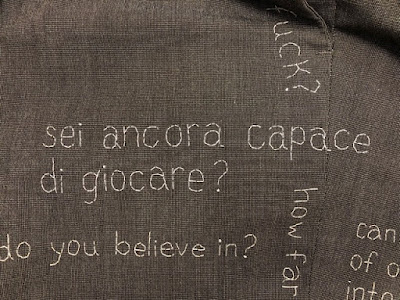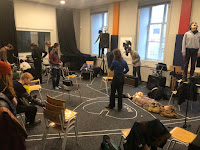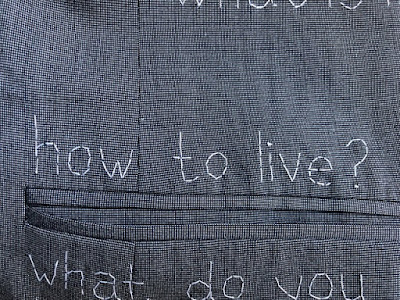I walked around in a suit locally for a year, embroidered peoples' questions on it and had many wonderful encounters. Now I am taking the suit on a long performative walk through known and unknown territories.
31/01/2022
30/01/2022
29/01/2022
How to land?
I came home to my little house in the forest after not having been there for more than a month. I opened the mailbox, and found a postcard I knew would be there. When I walked up to the door I noticed that the seagull had fallen from the tree. For years it had floated in mid-air next to the wooden bench, suspended from a branch with a thin thread, spinning around on windy days, always looking angry. I could see the green mosses on his white plastic back more clearly now and his angry eyes were hidden. Should I pick him up and hang him back? Maybe not, he looked quite peaceful there, inbetween the ivy.
I went inside and read the postcard. It was a message from my older me to my present me. It said: “Dear me, you, how shall we call ourselves, the present and the future version of me? I hope they are one and will stay as manifold at the same time but in a better balance while reading this than while writing this. And that time has been found! Love, me you we.”
In case you wonder: I am not in the habit of sending postcards to myself. In the last meeting with my colleagues in the New Creative Technology course organised by the Arts Academy where I am working, we were asked to write ourselves a message. I asked my students to do something similar a few days ago, not a postcard though, a letter.
The whole week I had been working with eighteen third year students on the theme of metamorphosis. “Metamorphosis is a biological process by which an animal physically develops after birth or hatching, involving a conspicuous and relatively abrupt change in the animal's body structure through cell growth and differentiation.” (Wikipedia) We worked on a transformation on three levels: individually (by developing alter ego’s), in space (= the rooms they were working in, we had started the week by emptying them completely), and as a group.
Who am I? Who do I want to be? Where am I? Where do I want to be? Who are we? Who do we want to be? Where are we? Where do we want to be?
The week had ended with a lunch, everybody arrived as their alter ego. While sharing food little interventions happened, and we got to know an other side, a new manifestation of the people we thought we knew. Sometimes this new manifestation was already familiar to us, sometimes it was a complete surprise, something we hadn’t noticed before, had been hidden, eager to come out, waiting for the right moment.
I came to the lunch as myself, but I guess we all did. I was wearing the three piece suit I had been wearing every day since the middle of October, when I was supposed to go on a long walk from Amsterdam to the COP26 in Glasgow, walking in what in the past was called a three piece walking suit, embroidering a question on my suit every day. The walk didn’t happen but I put on the suit anyway and instead of collecting questions on the road, I got questions from people around me, in everyday life, on social media, strangers I encountered in the street, questions about the state of the world, the state of their own own world.
“Who am I?” was one of the questions I embroidered, on my left sleeve. “Who is they?” I embroidered on the right. “What does it mean to be anonymous”? “Do you know your neighbour’s name?”
On the waistcoat there was a question of my own. “They say we are running out of time but if we change our approach to time, can we connect with the world and everything in it in a different way?” It was the question I sent in to apply for Becoming Earhtly.
I had read Nora Bateson’s “Identity with an I” from “Small Arcs of Larger Circles” to my students. It seemed to make perfect sense to share it with them, exploring all the different sides of them, seeing themselves as plural, as being many I’s. Paolo, our third thought host for the third Becoming Earthly meeting sent it to us. It starts like this:
“Who am I? Grammar incorrectly suggests that I am singular. A verb conjugation for plural first person is missing - not for we but for I. That singularity is a semantic, ideological, epistemological, cultural, biological, ecological, evolutionary, epigenetic, gender specific, nationalistic error. That singularity is a great violence, and silence to all that I am in plurals…. What there are no words for is often un-seeable. Can you see the plurals that I am?”
And it continues:
“Over 10 trillion organisms make their community in and on my body. I cannot live without them ….. Nine out of ten cells in my body are inhuman and belong to the larger ecology …. I am not only what is in my body, I am also my personality, my culture, my emotions, my spirit. Finding where exactly the outside world ends and I begin - is not so easy …. We, the internal aquarium of trillion of creatures, my language, my culture, my love, my ideas, my family, my nation, and my breakfast - ARE. And we ARE not seperable from the particular version of a person that is me.”
Our third Becoming Earthly meeting happened shorly after the Metamorphosis lunch ended. I was still a bit high on adrenaline. I hadn’t managed to read all of the article by Tim Ingold - Culture on the ground. The world perceived through the feet”, an anthropologist I admire deeply and had the pleasure to meet once after I walked from the east to the west of Belgium with a group of artists in the four week Sideways walking festival. The suit I walked in then has a drawing on it I embroidered while listening to him giving a lecture in the closing conference of the festival.
We were asked to wear comfortable clothing for this BE Zoom meeting and have something to lie on because it would involve a 50 minute Feldenkrais lesson. My suit is the only thing I am wearing and it is comfortable (that is how it once started: when I discovered that the current business suit was once called a walking suit, I wore one on a long walk to find out if is still suitable to walk in) but I was aware that I hadn’t shared my project with the other group members and I wondered what they thought, seeing me again in the same suit, especially this time when we were going to do some exercises. I was excited, Feldenkrais had not been part of my life for a long time but it brought back memories of a week in the Ufer studios in Berlin where in the mornings we did Feldenkrais and in the afternoon the walking artist Hamish Fulton introduced us to his practise and we walked in many ways.
It couldn’t have come at a better moment (although I don’t rule out any moment would have been the best moment), I was in need of landing after a hectic and intense week where the focus was on taking care of my students. Who am I? Where am I? The questions disappeared. I connected with the ground. I tried to feel its pull. My body felt lighter.
We were asked to do some automatic writing afterwards, with the question “What is landing?” in mind. Three times one minute. I started. “This is landing, i have landed, listening and being and i am landing in words, i understand what i am writing ….” Paolo was talking to us and I listened to his words while writing, ending the first minute with “i will listen to myself now and …. “
The second minute. The third minute. Then the task to select ten words. I couldn’t chose. Which words are the most important ones? How do you select? Maybe “forever”? Never? Slow? I understand? I don’t understand? Just breath? Time left? It became even harder when we had to pick just one. I had the feeling I would be judged by the word I chose. It should be one with meaning. An important word. Or shouldn’t it? I chose “just”. Not the adjective but the adverb. As in “just when”, “just say it”, a humble word somehow. “Just breath”.
But going over my text again, when we talked in little groups, I didn’t feel so humble myself. The word most used in my text was “i” and it didn’t make a difference I hadn’t used capitals.
We talked about falling. I thought about Bas Jan Ader, who filmed his falls (from a roof, with a bike in the Amsterdam canals, from a tree). Ader, who disappeared at sea with his little boat during a journey that was part of his “In Search of the Miraculous” triptych once wrote in his notebook: “All is falling”. Many artists before and after him fell intentionally. The first “action” Tehching Hsieh, famous for his One Year performances, performed after he decided to quit painting, was to jump from a second-floor window onto concrete, breaking both of his ankles. Many artists have written about falling.
“You're walking. And you don't always realize it,
but you're always falling.
With each step you fall forward slightly.
And then catch yourself from falling.
Over and over, you're falling.
And then catching yourself from falling.
And this is how you can be walking and falling
at the same time.”
— Laurie Anderson, Walking and Falling
Do you ever wake up just after you have fallen asleep because you experience a shocking falling sensation? Did you ever wonder why that happens? The sleep start, or “hypnagogic jerk” might have an evolutionary function, giving you the opportunity to check your environment for a last time or your body position (in case you fell asleep in a tree). Do you ever fly in your dreams? As a kid I did. I remember knowing in my dreams I could fly and if I tried hard, I managed. I haven’t flown in my dreams for years, decades maybe. I don’t believe I have the capacity to fly anymore, but I don’t mind. I can walk.
I once wrote: “Some people would rather have wings but we don’t, we have feet. We were born to walk. Scientists say that walking gave us our brain capacity, walking turned us into the human beings we are. Walking made it possible for us to have the desire to fly and to come up with ways to turn our dreams into reality.
Walking made us fly. We can go anywhere. Still the easier it becomes to move through this world, the more disconnected we seem to get from it. We have to land again. Get close to the things. Be part of the world. Walking teaches us where we are, who we are. A slow speed makes our brain work fast. Makes us see more. Be more. And best of all: walking makes time disappear.”
(A Soft Armour, Dark Mountain 2014)
I don’t fall often, hardly ever on purpose. When I fall, after the first confusion, after checking if there are minor wounds, torn clothes, there is always a sense of wonder, of understanding. I was off balance. My mind was overloaded. My body wanted me to land. I have to create balance in my life.
After I came home, after I noticed the moss on the fallen bird (and remembered how we talked about mosses in the group meeting), after I read the postcard, I finished reading the Tim Ingold article. He writes about the groundlessness of modern society, but also how the world has no surface: “Human beings live in the world not on it.” And writing about feet and steps: “Rhythmic rather than metronomic, what they beat out is not a metric of constant intervals but a pattern of lived time and space.” “Walking is itself a form of circumambulatory knowing” and “Indeed it could be said that walking is a highly intelligent activity.”
The quote I liked most was not by him, but by C. Tilley, from A Phenomenology of Landscapes: “Through walking … landscapes are woven into life, and lives are woven into the landscape, in a process that is continuous and never-ending.”
A Soft Armour: https://dark-mountain.net/a-soft-armour/
Bas Jan Ader, Legend of the Fall: https://www.artforum.com/print/199903/legend-of-the-fall-bas-jan-ader-32333
Tehching Hsieh: https://www.artsy.net/article/artsy-editorial-performance-artist-tied-woman-year
Falling to sleep: https://theconversation.com/why-do-you-feel-like-youre-falling-when-you-go-to-sleep-62059
28/01/2022
How do you grow things?
In the middle of "Metamorphosis", two week project with 3d year students Musician 3.0, HKU Conservatory Utrecht.
27/01/2022
25/01/2022
24/01/2022
How well do you walk through the fire?
I do not fear the fire
I do fear getting burned
(text in chalk left by somebody on a square in Utrecht, text on the suit "how well do you walk through the fire" was embroidered a few weeks ago)
23/01/2022
22/01/2022
20/01/2022
19/01/2022
18/01/2022
17/01/2022
16/01/2022
14/01/2022
13/01/2022
12/01/2022
11/01/2022
09/01/2022
07/01/2022
06/01/2022
04/01/2022
-
What does belonging mean? What is my territory? What is yours? What do you truly own? Where is the wild? How to listen to non-human voices? ...
-
For a long time I have been thinking about walking to the COP 26, the United Nations Climate Conference in Glasgow. In 2015 I walked from Ba...
-
Writing is traveling backwards and forwards at the same time, revisiting memories and thoughts and creating new connections and insights. In...



















































.jpeg)